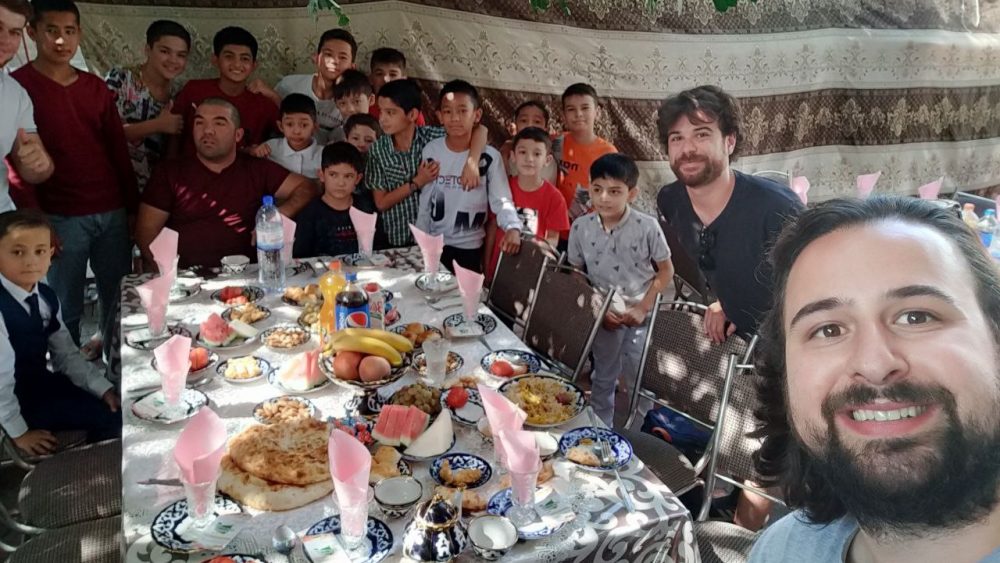By Gian Luca Traverso and Carlo Nicoli Aldini
The last day in Samarkand was supposed to be a calm, relaxing day. We had already visited the most important sites in the city, so we did not have any particular place to go. We decided to go to Registan square at around 10 am, and we started to work outside, at the tables of a little lovely bar facing the astonishing view of Registan. After a while, we started to walk aimlessly in the alleys of the city centre behind the square, looking for a place to eat. Here the magic happened. During our aimless stroll, we stumbled into a group of elders who invited us to a wedding. That was not prepared, they did not know us, but still, they called us inside the inner courtyard, and we were immediately surrounded by a large crowd of people. Before we knew it, we realized that we were in the middle of a wedding feast.
There were a lot of children, one of them was 15-year old and spoke perfect English with an American accent as, to our surprise, he explained he lived in the US for six years. The courtyard was strictly divided between men and women, with a curtain hanging in the middle of the yard that separated them. It was difficult for us to understand the relationships between the guests: they were not all relatives; instead, they were neighbours, it seemed in fact that the entire neighbourhood was present. Even if it was difficult for us to grasp the precise network of relationships, it felt clear that, in that context, there was a strong feeling of kinship. We ate together with the men and some elders. Besides the 15-year-old kid we mentioned, there were two other English-speakers: one of them was a 16-year-old boy who studied to become an actor. After a big lunch, with a lot of plov, soup and vodka, attendees went outside to pick the bride from her house.

Accompanied by local folk music played by a fun loud band, we entered a little alley that was just a few steps away from the restaurant and stopped at the doorstep of what must have been the bride’s house. At this point, people started to engage in many rituals, which we observed curious and confused at the same time. First, several young men started to pull a rope to win it over the other contenders. They engaged in a kind of all-against-all tug-of-war, which escalated quickly as two of them started to confront each other in a fighting mode. Upon asking for explanations to the 15-year-old English speaking boy, we were told that the fight arose as both men lamented being skipped in the order that was supposed to be respected while pulling the rope. That explanation came as a surprise to us: what to us looked like a lawless fight over a rope, had instead a specific regulation over its performance. In any case, the fight was quickly sedated by the elders, who spoke to both men and found a way to conciliate the debate. Encouraged by the elders’ intercession, we could see the two men walking together along an alley close-by, finally exchanging their views on what had happened in a calm and peaceful manner. For us, it was very interesting to observe the role the elders had in resolving the fight and their authority over the youngsters. Their intervention indeed rapidly sedated the quarrel, and thus restored the order.

Meanwhile, music and dancing proceeded in front of the bride’s house, and many people encouraged us to enter. We were a bit sceptical at first, as we felt afraid of intruding in a very familial setting. Upon continuous invitations, we decided to enter the bride house where we saw the groom – clothed with a cloak and a traditional hat – and the bride standing in the corner of a little room, surrounded by many people including who we understood was the groom’s mother. Here again, we were able to see them performing a ritual. The groom’s mother was, in fact, reciting some words to the married couple, which we inferred were the duʿāʾ, as everybody was keeping their hands in the gesture Uzbek people usually have when praying Allah. We experienced this moment as the climax of the entire ceremony, and as soon as the recital was over, attendees started to leave as the wedding feast came to an end. Upon recognizing how lucky we had been to have had the unexpected opportunity to be part of such a special moment, we left too, not before having thanked everybody who had made us feel welcomed and included in this glimpse of Uzbek lifeworld.
On the train on our way back to Tashkent, we talked and thought a lot about what we had just witnessed. Sure enough, we had found a welcoming community, with deep-rooted costumes and traditions that heavily regulated the wedding ceremony. At the same time, as socio-legal researchers, we could not stop wondering about the nature of those rituals. Were they expressions of living law? What kind of relationships do these informalities have with Uzbekistan’s official laws on marriage? While we could observe a high degree of unspoken in our experience, including some gestures and behaviours that truly seemed to have some kind of normative force, it was still very difficult for us to draw a line between the blurry boundaries of law and custom, of seen and unseen. Upon sharing our experience with lawyers at the Academy of the General Prosecutor’s Office where we both do research at the moment, we were informed that, as per Uzbek state law, the wedding must be registered at a public registry. However, this mere fact does not answer our questions, because our observations are increasingly suggesting to us that, in Uzbek society, the unseen customs might still have more normative force than the state law.


